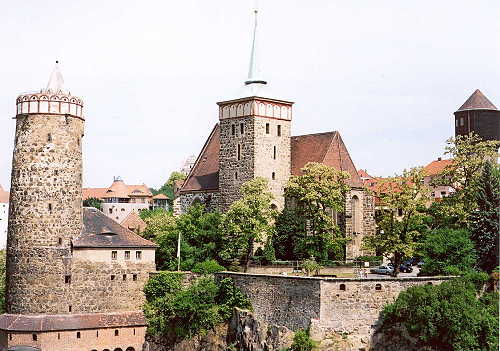Berlin, Colditz and Dresden
Contents
- Berlin - Brandenburg Gate
- Berlin - Kaiser Wilhelm Gedächtnis Kirche
- Berlin - Checkpoint Charlie
- Berlin - Gedenkstätte Deutscher Widerstand
- Berlin - Berliner Dom und Fernsehturm
- Berlin - Sony Centre
- Berlin (Potsdam) - Schloss Sanssouci
- Colditz Castle - Entrance Gateway
- Colditz Castle - French Tunnel
- Dresden - Semperoper
- Dresden - Zwinger
- Dresden - Fürstenzug
- Dresden - Residenzschloss
- Festung Königstein
- Cycling to the Bastei
- Erzgebirge
- Bautzen
The Brandenburg Gate rises up at the westerly end of the Pariser Platz and can be seen for miles around. It was once the symbol of divided Germany but also became the symbol of German reunification in November 1989.
The Gate was erected by the architect Carl Gotthard Langhans out of sandstone in 1788-91. It is based on the magnificent entrance area of the Acropolis in Athens. At the same time, however, Langhans assimilated a typical feature of the Roman Empire - the Quadriga, a victory chariot pulled by four horses
The Brandenburg Gate served originally as a City Gate whilst at the same time serving as a splendid conclusion to the Boulevard Unter den Linden. It was opened to traffic on the 6th August 1791.
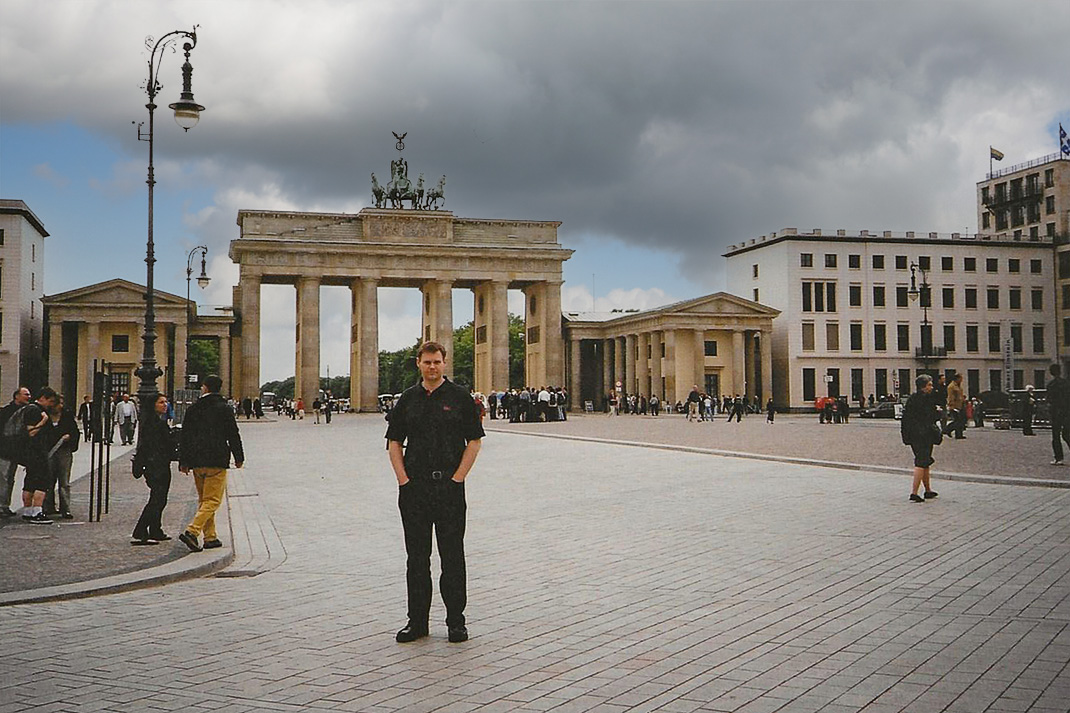
The 5 metre high Quadriga with Victoria the Godess of Victory was constructed by Johann Gottfried Schadow. It could only be erected in 1795, however, because of an argument over the figure. In order to remain true to the classical tradition, Victoria should have driven the chariot naked. However, she had to look in the direction of Berlin Castle and you can imagine, therefore, the view which would greet visitors approaching Berlin from a westerly direction - a naked bottom. Kaiser Frederick William II therefore arranged for Victoria to be covered with a robe.
Both the Gate and the Quadriga have had an eventful history. On the 27th October 1806 the Emperor Napoleon entered through the Brandenburg Gate and occupied the Prussian capital. In accordance with the rights of a victor, he had the Quadriga dismantled and packed it away in 12 boxes which he then transported to Paris. In consequence of Napoleon's eventual defeat, the Quadriga was transported back to Berlin in 1814. In memory of the struggle against Napoleon's troops Victoria was decorated with an Iron Cross, a laurel wreath and the Prussian Eagle.
In 1945 the Brandenburg Gate was badly damaged and the Quadriga lay in ruins. In the western part of the city were only the 5000 unnumbered parts of a plaster cast which had been prepared in 1942 These were used to reconstruct the Quadriga in 1957. It was the only joint reconstruction project carried out by the two opposing power blocks. The East German leader, however, required the Prussian Eagle and Iron Cross be left off and therefore, during the Cold War period Victoria instead held a staff with an oak leaf crown in her hand. Only with its reconstruction after German reunification in 1991 did the Prussian Eagle and Iron Cross reappear.
Controversy has raged since reunification over the question as to whether vehicular traffic should once again be allowed to pass through the Gate. In the meantime only pedestrians and cyclists are allowed to pass through the 20m high, 65m wide and 11 metre deep monument. After comprehensive restoration Berlin's most famous landmark was again revealed on the 3rd October 2002. The event was marked with great festivities
Immediately after his accession to the throne Kaiser William II
gave his instructions for the construction of an imposing church which, above all in its
inner space, should demonstrate the unity of the throne and altar in Prussia and which
should be devoted to the memory of Kaiser William I.
Franz Heinrich Schwechten built the church in neoromantic
style with a high West Tower as well as four corner towers.
The church didn't play a particularly important role in the
church life of the following century even though it was here in 1921 that the former
silent film star Henny Porten got married dressed completely in white.
On "Totensonntag" (Dead Sunday) in November 1943 bombing by
the Allied Forces destroyed the church with only the West Tower left standing.
In 1957 it was decided to demolish the ruins but the people of
Berlin protested so strongly that a compromise was agreed: The Tower
(in the meantime called "the tooth with holes") remained standing and a
flat octagonal building was erected which is covered with glazed concrete sheets.
In addition a sacristy, a library and a further 53m high tower were constructed.
The new church was consecrated on the 17th December 1961.
The whole ensemble is now known by the people of Berlin
as "Puderdose und Lippenstift" ("Powder Case and Lipstick"). A "Hall of Thought" in the Tower calls for peace and
reconciliation. On the "Fürstenfries" (Princes Frieze) the Hohenzollern rulers
from Elector Frederick I (1415-40) to the last Crown Prince Frederick William are depicted.
Every hour chimes resound in the old Tower -
a melody written by Prince Louis Ferdinand, the great uncle of the last Kaiser.
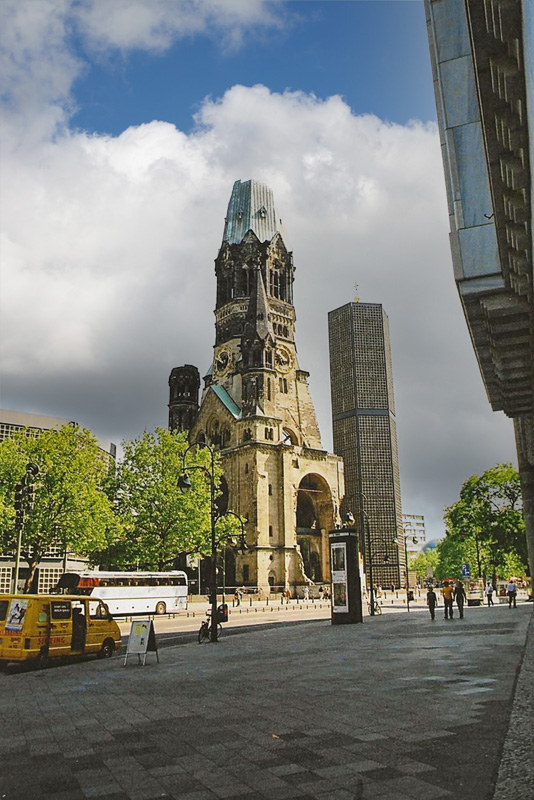
In the Cold War years "Checkpoint Charlie" was often in the headlines.
It was here, for the first time on the 27th October 1961, that tanks from the USA and
Soviet Union stood facing each other at a distance of only 200 metres. It was only two months
previously that the building of the Berlin Wall had made a cul-de-sac out of the once beloved
Friedrichstraße.
Until the fall of the Wall in 1989,
only diplomats and military personnel from the victorious powers could cross the closely-watched
passage between the East and the West.
On the 22nd June 1990 the Allied control point was finally dismantled
Nowadays there are only a few remains of the Wall (on sale in a nearby shop!), a watchpost and a sign
saying "Achtung! Sie verlassen den amerikanischen Sektor!" ("Attention! You are leaving the American
Sector!")
As is generally the situation all over Berlin, there has been much
building work in the area in the last few years. As a result the Checkpoint is now surrounded by
modern offices and living accommodation.
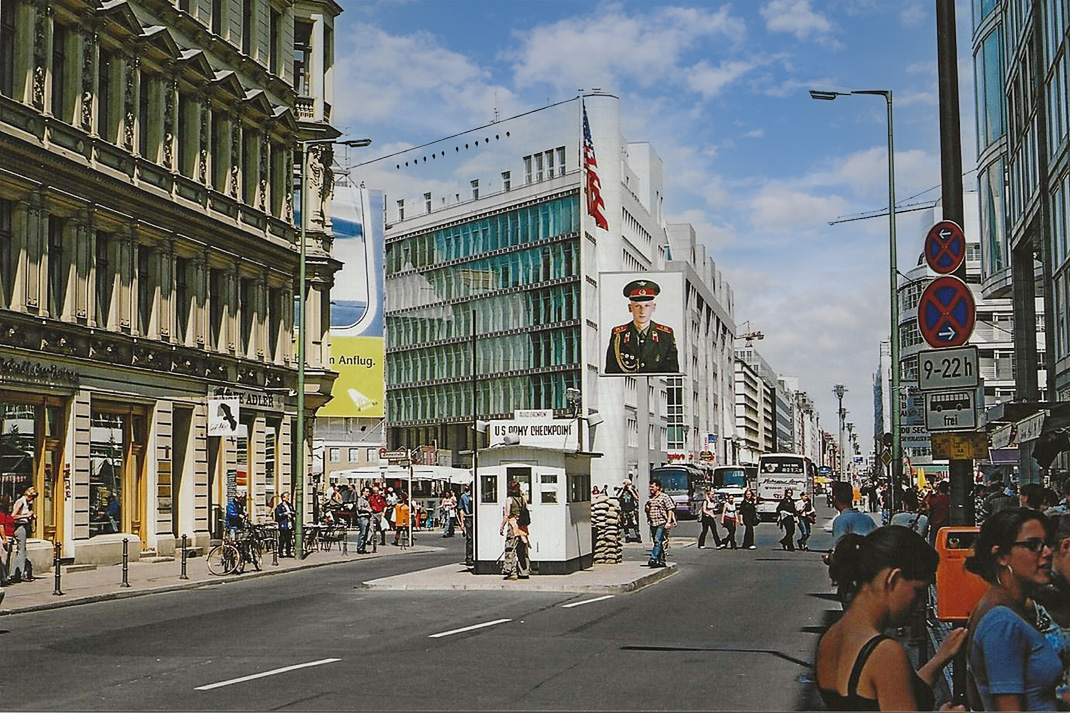
Not far from the Checkpoint itself is the "Mauermuseum Haus am Checkpoint Charlie". This is a museum which documents the history of the wall and life in the divided city from 1961 to 1989.
In the courtyard of the former Naval Office is a monument to the
victims of an uprising against the Nazi Regime on the 20th July 1944.
There is also a plaque
and wreath marking the place of execution (by firing squad) of the officers: von Stauffenberg,
von Quirnheim, von Haeften and Olbricht.
One of the buildings surrounding the courtyard was used
between 1935 and 1945 as the offices of the supreme command of the Wehrmacht. On the second floor
of this building there is now an exhibition on the theme of "Widerstand gegen den Nationalsozialismus"
(Opposition to National Socialism).
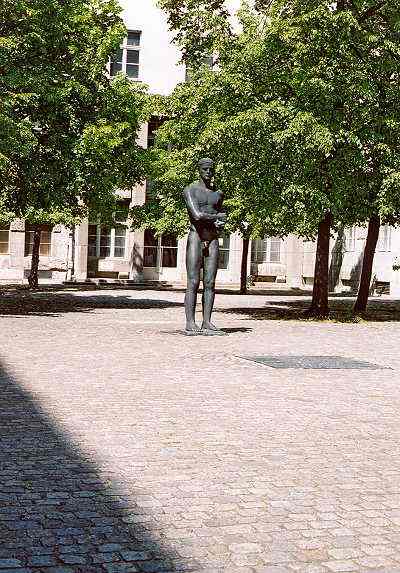
Pat and I took a city tour by bus on the second day of our stay in
Berlin. It's a good way to see the city as you can get off the bus at any stop, have a walk around,
take a few photos and get on the next bus that comes along.
One of the stops we got off at was in front of the "Berliner Dom"
(Berlin Cathedral) which you can see in the photograph here. We were lucky enough to witness a
wedding which was taking place in the Cathedral at that time.
To the right-hand side of the Cathedral you can see the "Fernsehturm"
(television tower). It's about 365 metres high (more than 3 times the height of Blackpool Tower!)
and at a height of 207 metres is a revolving restaurant. Of course Pat and I took the opportunity
of having a meal in this restaurant and enjoying the panoramic views of Berlin passing infront of
our eyes.

Both Pat and I look back on this particular experience as the highlight of our stay in Berlin. The television tower, and particularly the restaurant, is the one place you musn't miss if you ever visit Berlin!
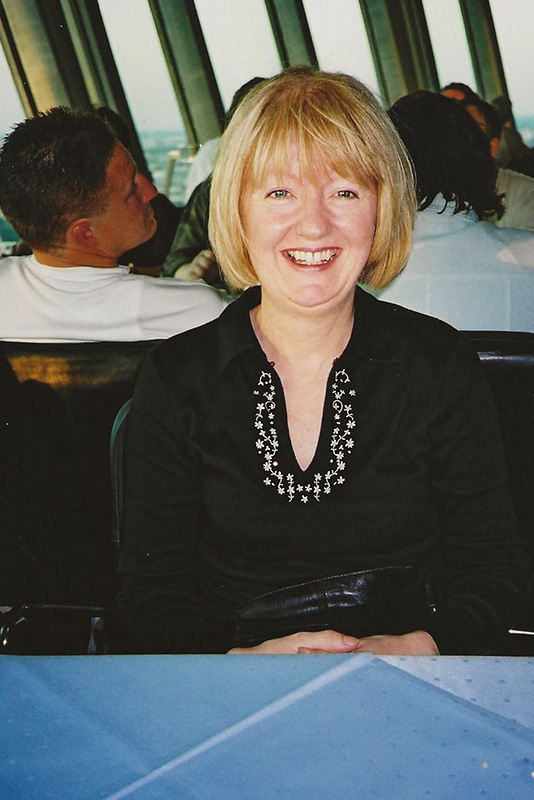
The Sony Centre is part of a huge new development taking place at Potsdamer Platz in Berlin. The cinema there plays the original English versions of the latest cinema releases and therefore Pat and I took the opportunity to watch "The Matrix Reloaded".
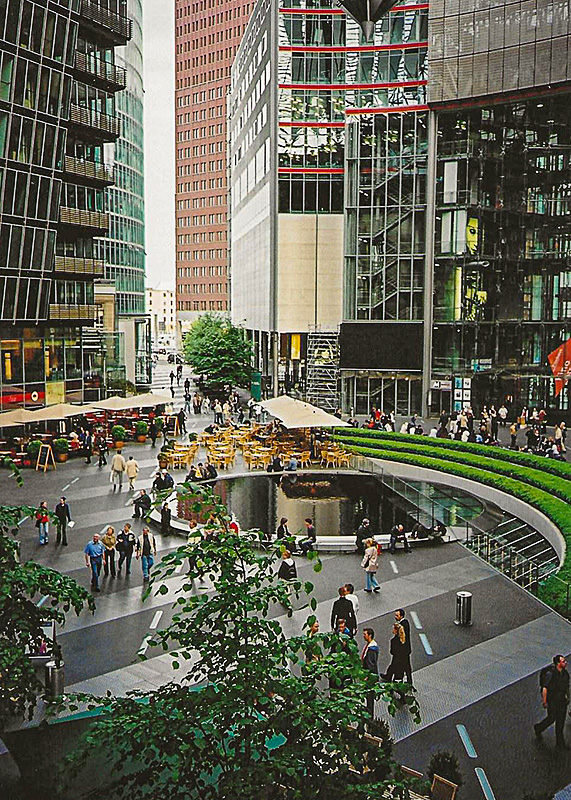
Schloss Charlottenburg was built in 1695. It was used as a summer
residence for Fredrick III and his wife, Charlotte.
It was further extended and came to be regarded as the most splendid
example of the baroque architecture of the Hohenzollern family. It took 100 years for the schloss to finally
have the appearance it bears today.
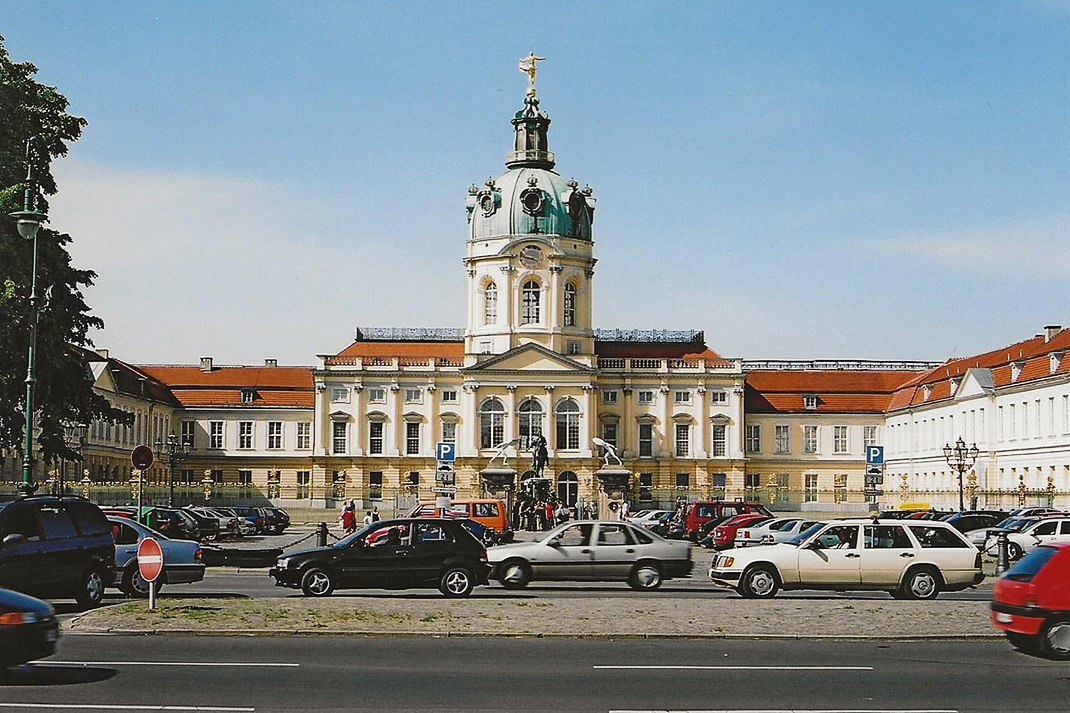
Potsdam lies just to the south west of Berlin. It is here that Fredrick the Great
created a palace which was to be the equivalent of Versailles.
The name "Sanssouci" comes from the French "Sans souci" or "without worries".
In his palace Fredrick could escape the trials and tribulations of his kingdom.

Another major highlight of our trip to Germany this year was our visit
to the former Prisoner-of-War Camp at Colditz Castle.
Colditz itself is a small town on the banks of the River Mulde
approximately 22 miles south-east of Leipzig and one hundred miles south of Berlin. The nearest
neutral border during the Second World War was Switzerland, over 200 miles away.
The prisoners would arrive at Colditz station and their first view
would be the massive structure of the castle dominating the town from its strongpoint on top
of a cliff on the other side of the River Mulde.
Having arrived at Colditz they were counted, marched over
the bridge, up into the town and finally arrived at the Castle Gate which you can see here.
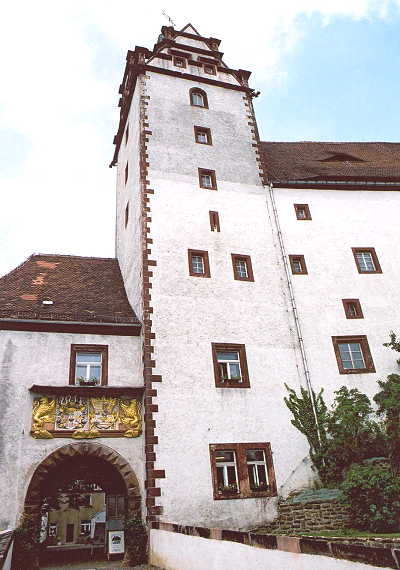
Nowadays just after the Gate is a notice giving statistics in relation to the escape attempts made. It's clear from this notice that the British must have been a constant source of problems to their German captors!
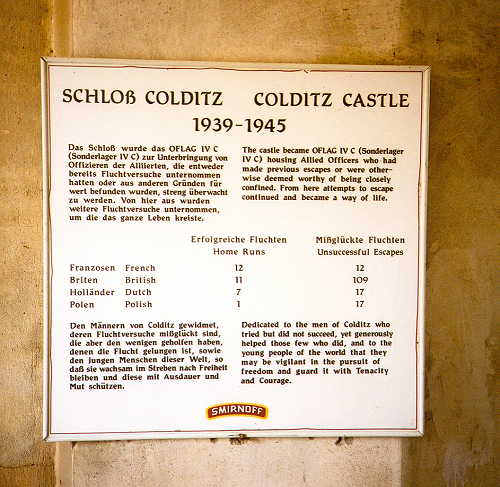
The French Tunnel was started on the top floor of the clock tower. From
here the French dug their way into a ventilation shaft which led down into the German wine cellar.
Pat is pictured here at the bottom of the tunnel as it enters the wine cellar. The French made a false
wall to conceal the fact that they had made their way into the cellar.
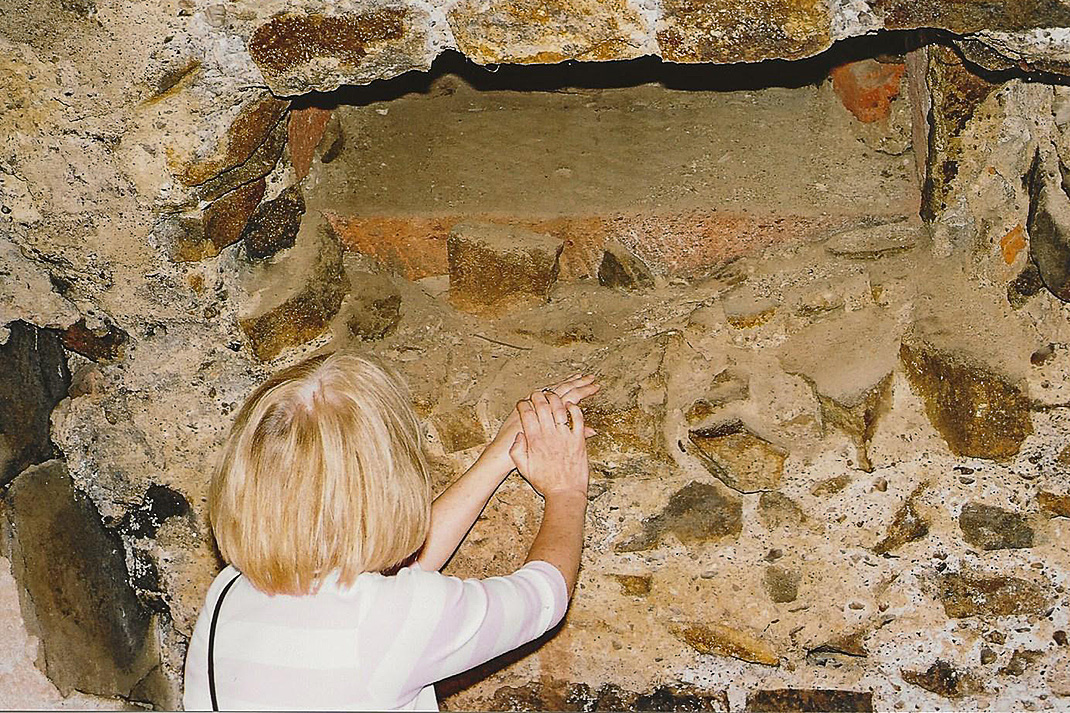
The prisoners then tunnelled through an adjoining wall into the Chapel. The following photo shows Pat stood in front of the entrance to this next part of the tunnel from the wine cellar
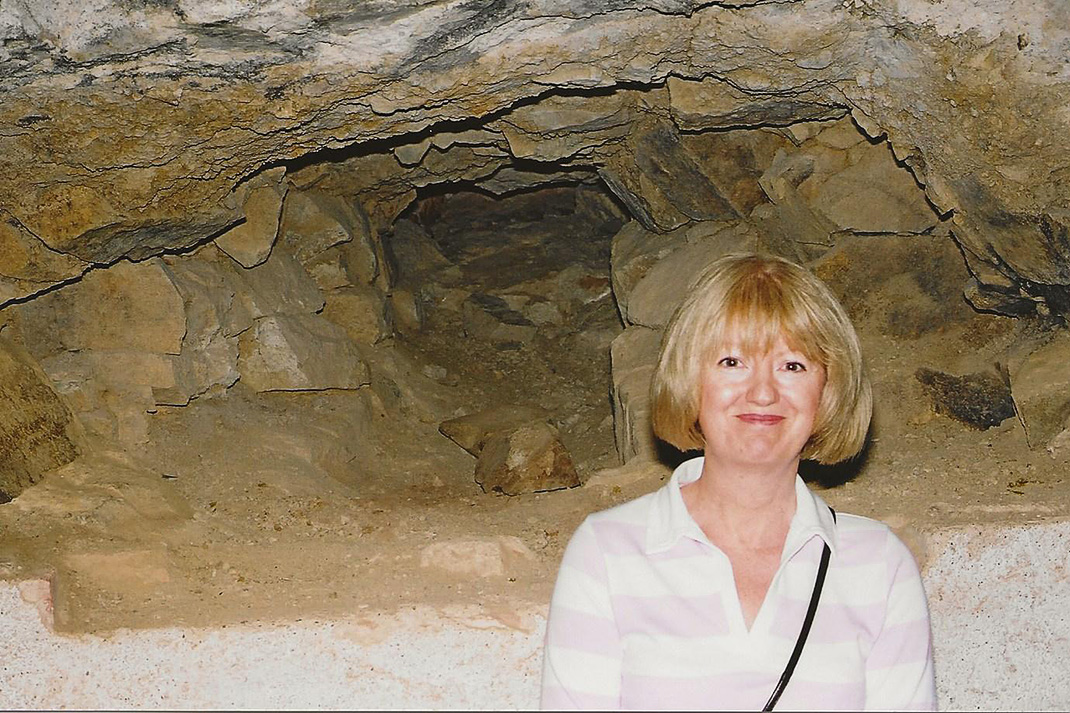
This route was chosen because it was hoped that a crypt would be found under the Chapel. However there wasn't one and therefore an upwards shaft was dug, emerging under the Chapel floor
The Chapel must have looked quite nice at the time but it's been left to detriorate in the years since and is now in need of considerable repair as you can see from this photo:
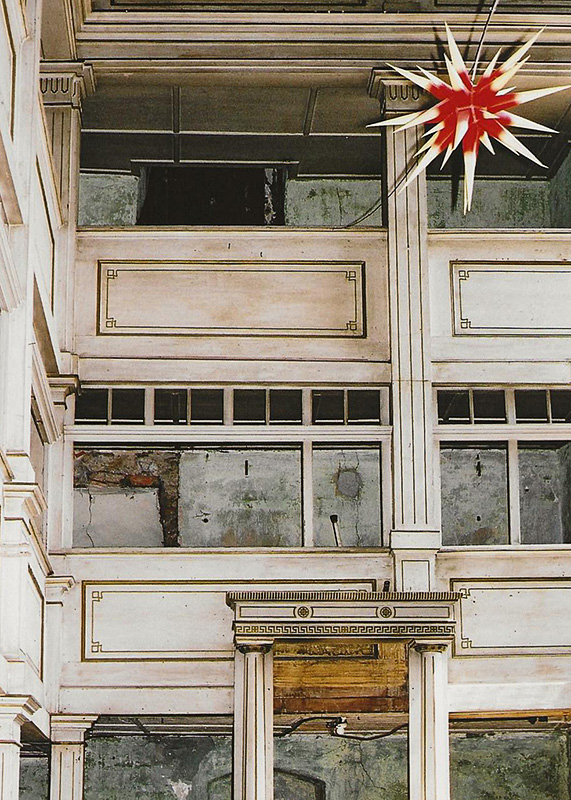
The French prisoners took their tunnel across the Chapel, sawing
through the great oak beams with hand-made tools (e.g. razor blades fixed to a length of wood).
Despite efforts to cover the noise of digging and the removal of rubbish,
the Germans were aware that something was going on. Nevertheless the tunnel remained undetected
until, with just a few feet to go, the Germans decided to inspect the clock tower. They made a hole
into the tower to inspect the weight shafts and lowered a small boy down. Unfortunately
a Frenchman was working in the tunnel at the time and the game was up - 18 months work was up!
Had the tunnel been successful it had been intended to include 200 prisoners in the escape attempt.
In the Castle you can see many of the instruments used in the various
escape attempts, photographs and drawings of prisoners, and the hiding place for a radio transmitter
which wasn't actually discovered until renovation works were being carried out on the castle in 1998!
The only disappointing aspect of a visit to Colditz Castle at the moment is that it is undergoing major repair and there is scaffolding covering much of the exterior of the Castle. This work will take many years to complete and it could be another 10 years or so before the Castle will really be able to be seen fully (we weren't able to see the Theatre for example which was the location of one of the most well-known British escape attempts).
After leaving Berlin we travelled south to Dresden. Here you can see
the Semperoper in Dresden which was built according to a plans by Gottfried Semper and opened for the
first time on the 12th April 1841.
From 1843 Richard Wagner was the leader of the orchestra here.
Unfortunately the building burnt down in 1869 but was rebuilt to the
same plans between 1871 and 1878 and the Semperoper became one of the most visited theatres in Europe.
The building was, however, together with much of the rest of Dresden, destroyed
by an Allied bombing attack in February 1945.
For many years after this only the ruins of this splendid building were
to be seen. It was only in 1977 that rebuilding work commenced. Again the original plans of Gottfried
Semper were followed. It was reopened on the 13th February 1985, exactly 40 years after its destruction.

Pat and I went to one of the concerts taking place in the Semperoper. It featured music by Mozart and William Walton.
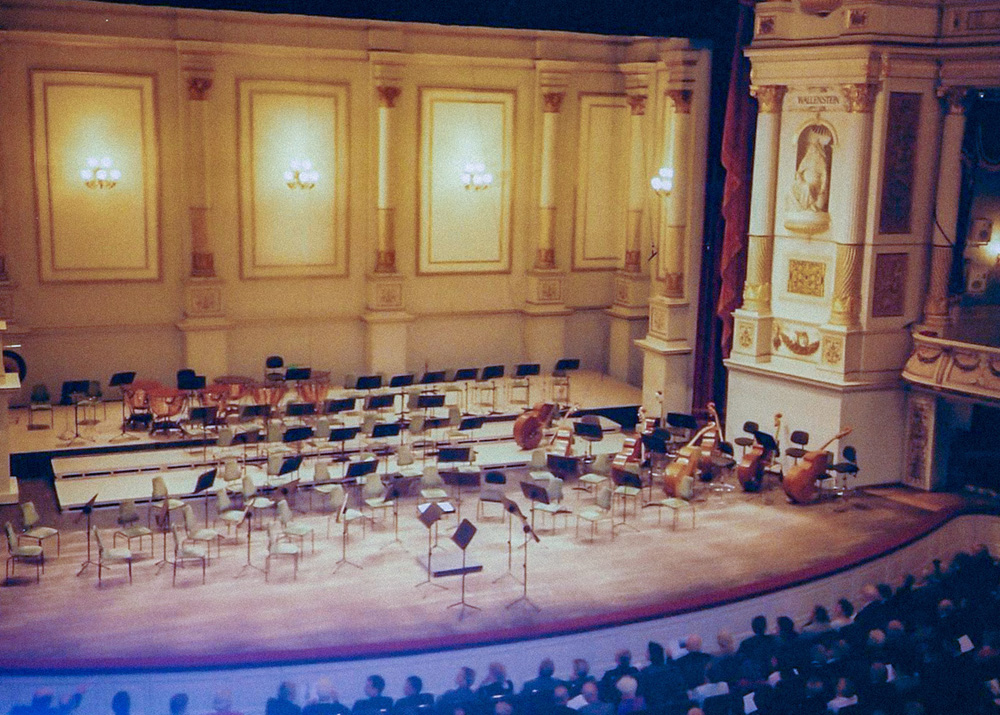
The Zwinger is a masterpiece of German baroque architecture. It was built
in several phases between 1710 and 1732. It orginally had a central courtyard surrounded on buildings
on three sides, but one hundred years later a fourth side was added and therefore the central grounds
became completely enclosed.
This building was also badly effected by the bombing in February 1945.
Indeed the people of Dresden believed at that time that their glorious building had been lost for ever.
Rebuilding work commenced, however, within a few months of the end of the war and
the building was largely restored by 1963.
In the Zwinger now you can visit the Art Gallery (containing works by
Titian, Raffael, Rembrandt, Rubens, Dürer, Canaletto and Holbein amongst others), an Armour museum,
a collection of Meissen porcelain and a museum of mathematical and other scientific instruments.
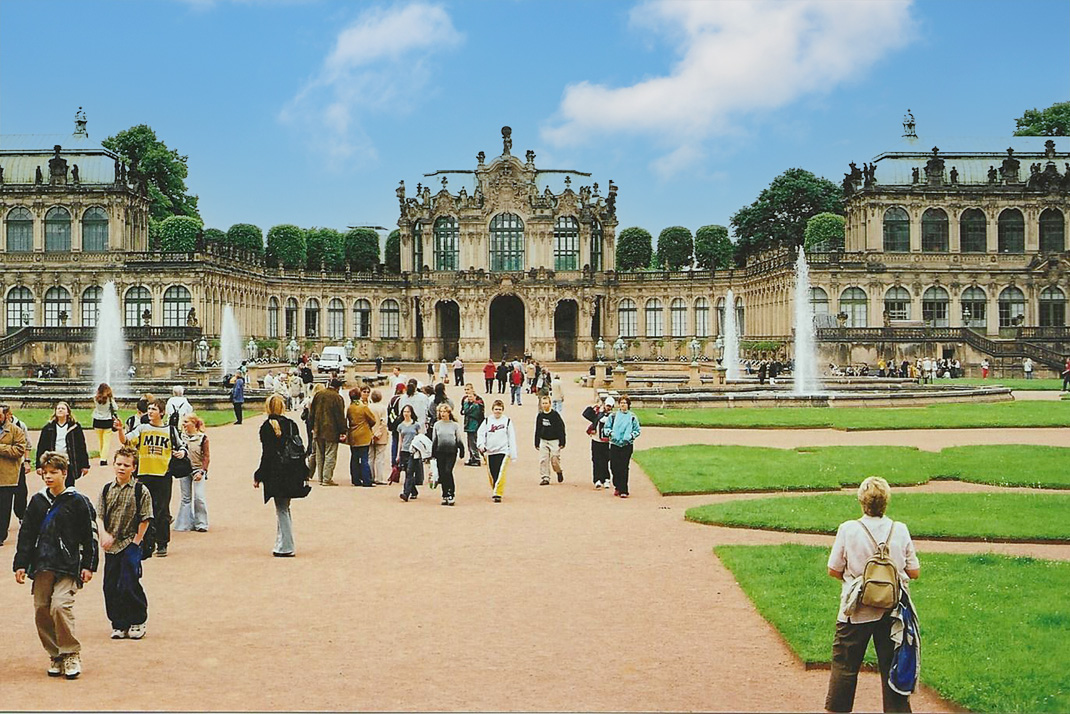
Along one of the walls on Auguststraße in Dresden is the Fürstenzug.
It is made of porcelain and is the largest example of its type in the world.
It depicts the rulers of the area (the Wettins) from 1123 to 1906. The character
in the centre of the picture which you can see here is Frederick the Gentle-Natured. After I had suggested this
translation to Pat, she looked at the picture and suggested that it would be more apt to translate it
as "Frederick the Puff" as he was the only ruler depicted holding hands with his two best mates
(both of which were male!)

This building was the residence of the ruling Wettin family. Following almost total destruction in the Second World War, it is currently being rebuilt and should be completely restored by 2006.
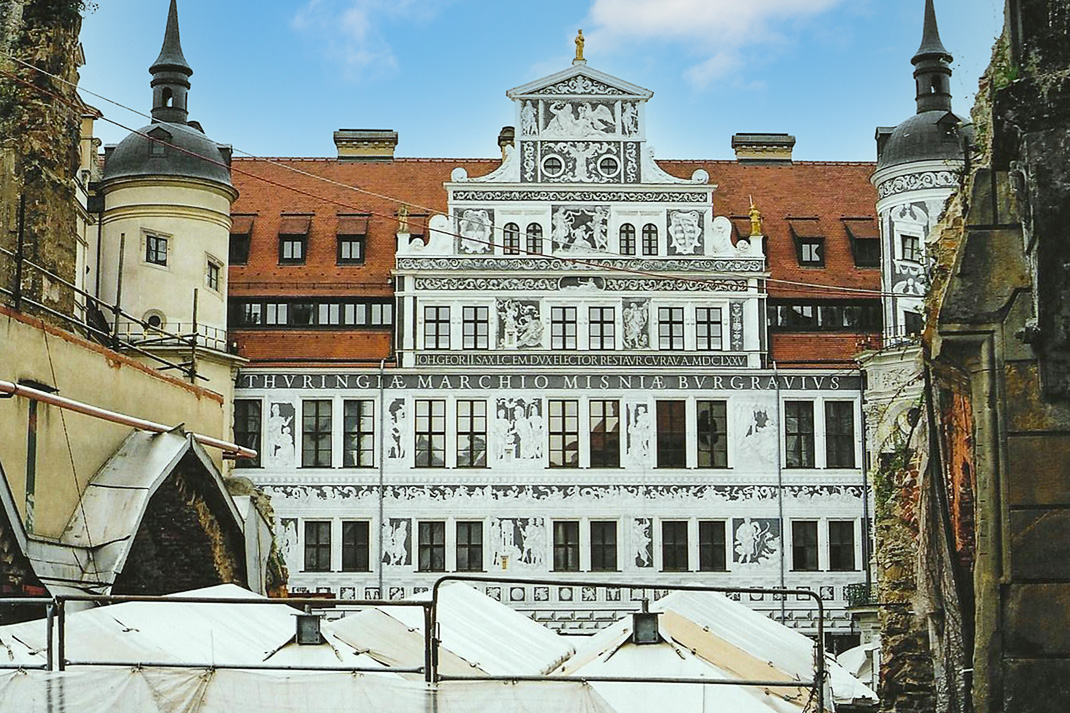
A few miles south of Dresden and situated near to the border with the Czech Republic
is the fortress of Königstein.
The fortress stands on a plateau 240 metres above the River Elbe. It is
a huge structure and has never been conquered or destroyed. It has housed the prince-bishops of Saxony
and their treasures as well as serving as a State prison.
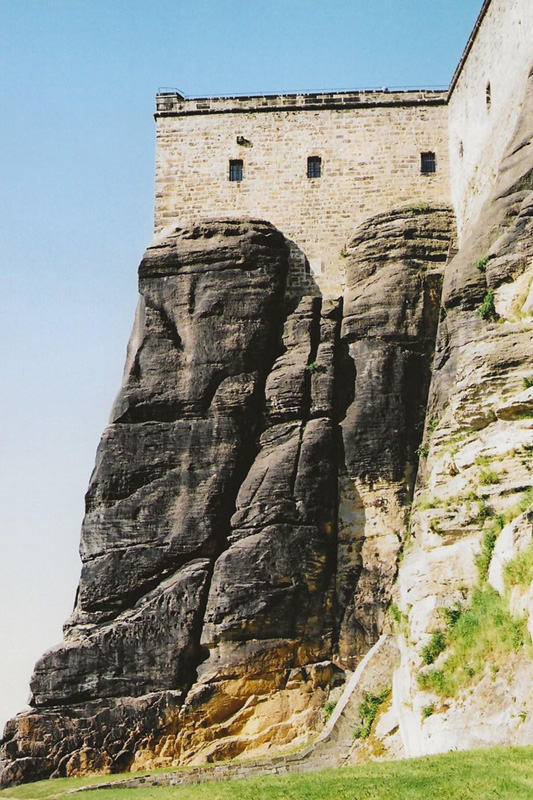
The River Elbe meanders past the fortress of Königstein.

The fortress enjoys tremendous views of the surrounding countryside. It was easy to spot the enemy approaching from miles away.
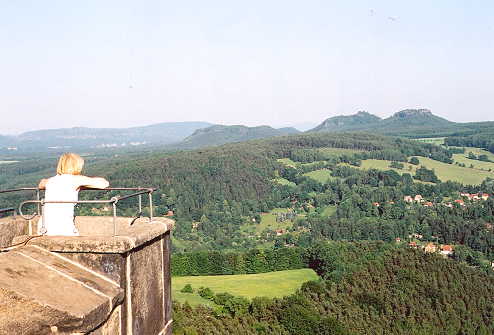
Of course there are many reminders within the fortress of its previous military importance. Here Pat's having a look down the barrel of one of several large cannons which guarded the approaches to the fortress.
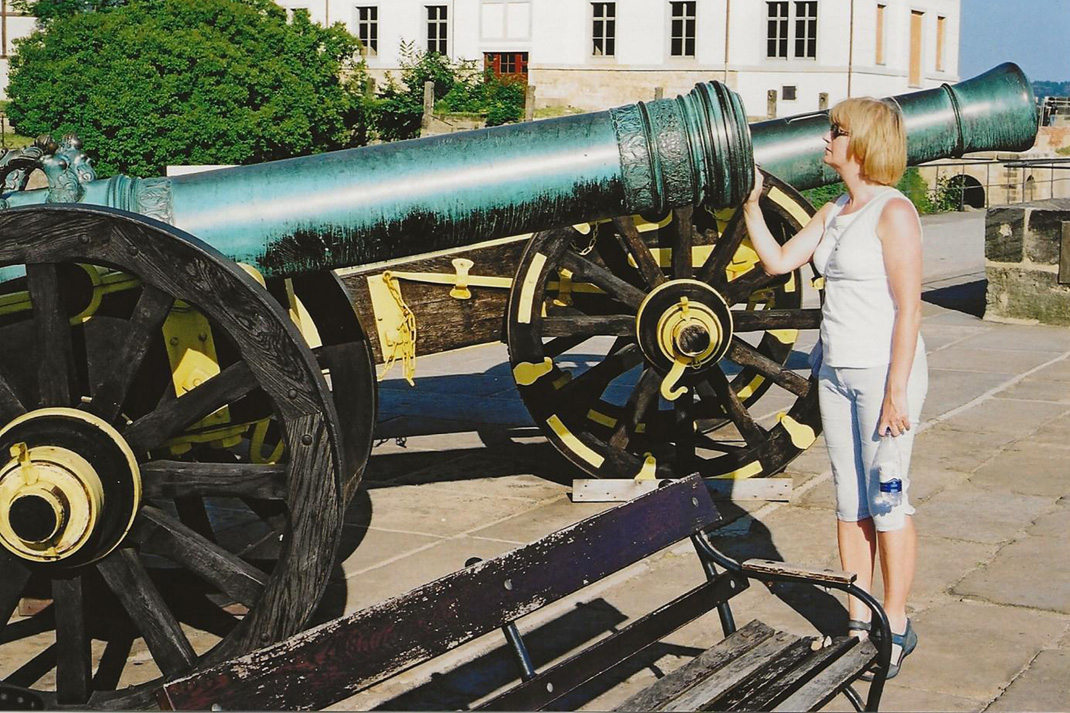
There are quite a lot of very nice rock formations in the area, such as the one which you can see in this picture. This particular part of Germany is known as "Saxon Switzerland".
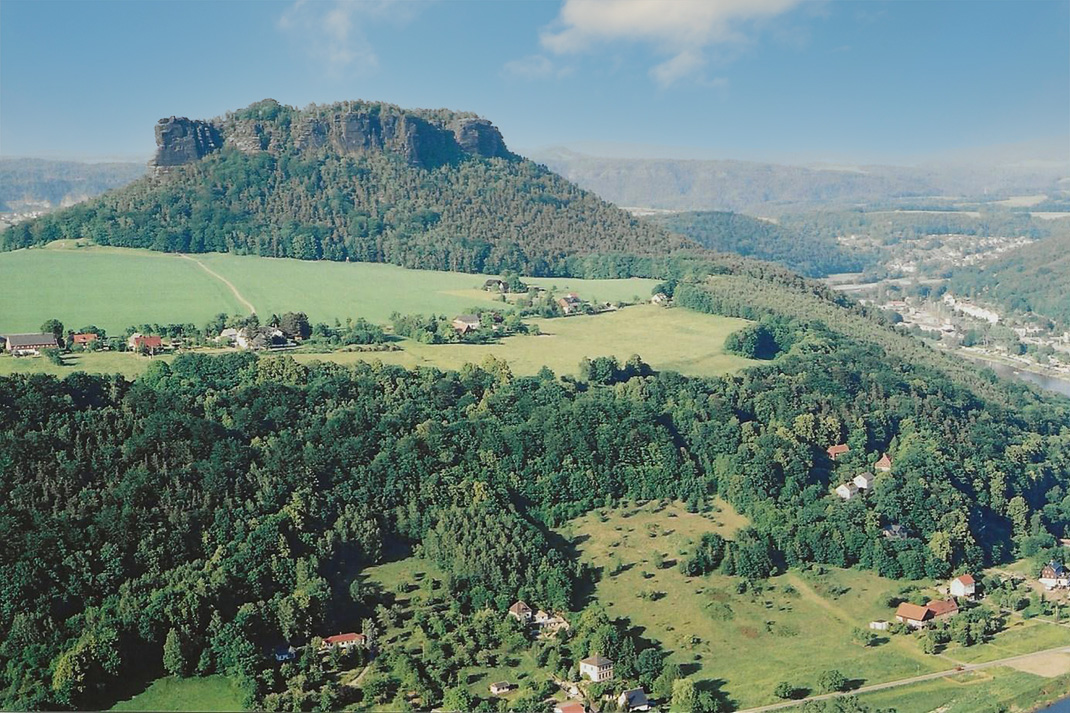
Before going to the fortress we decided to hire bikes from the tourist
information centre in the centre of Königstein. From there we cycled along the Elbe to the most well-known
of the rock formations, the Bastei.
We then headed back towards Königstein and carried on upstream
in the direction of the Czech Republic. We didn't have time to get all the way to the border. We
got as far as the border town of Bad Schandau and then turned back.
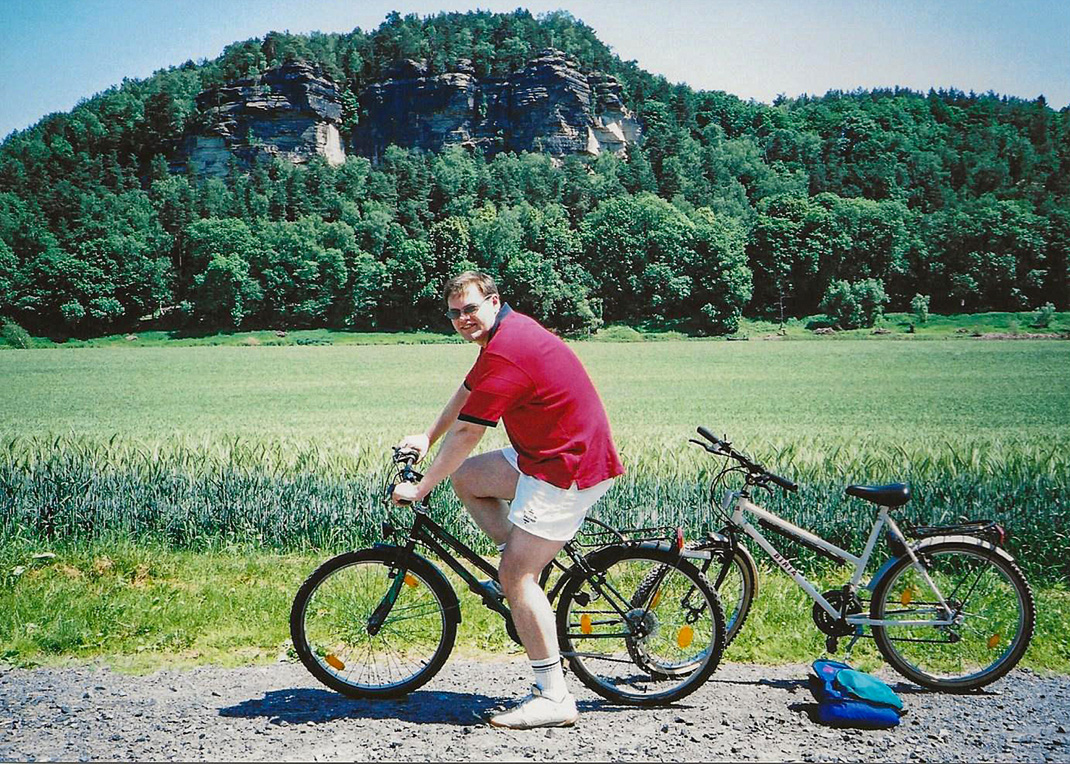
Whilst we were staying in Dresden we drove out to Stollberg near Chemnitz in order to meet up with our friend Karin. She took us round the Erzgebirge, a region of high ground in this area.
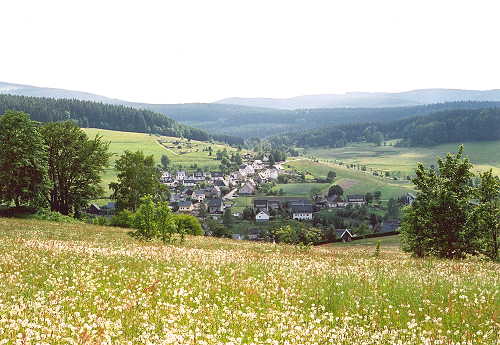
Is that me or is it Pat climbing up the rock face? Actually it's part of a model village which Karin took us to see.
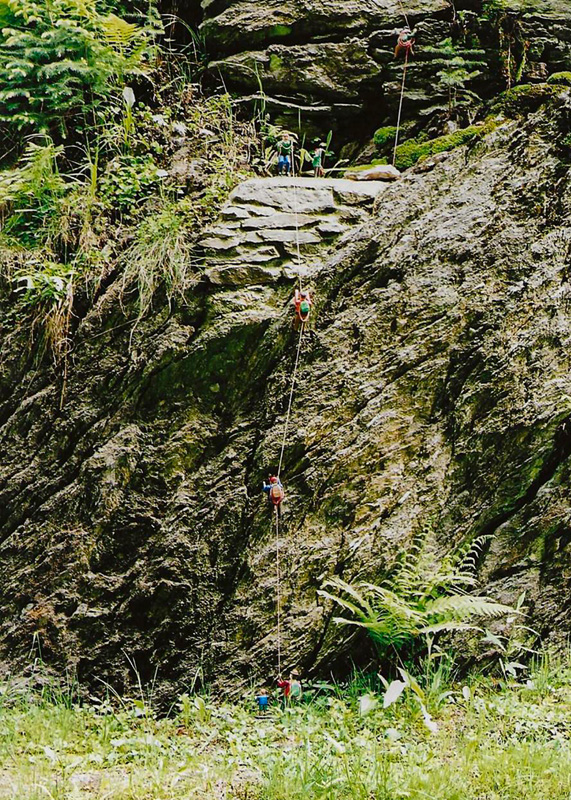
Karin explained that all the buildings in the model village, such as the one you can see in this photo were accurate replicas of actual buildings in the area.
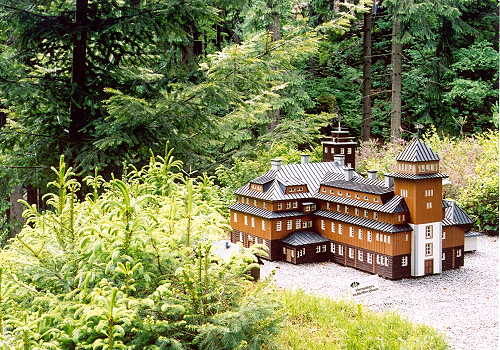
Well, that brings us to the end of this particular holiday. The last stop we made was at Bautzen which is close to the Polish border.
